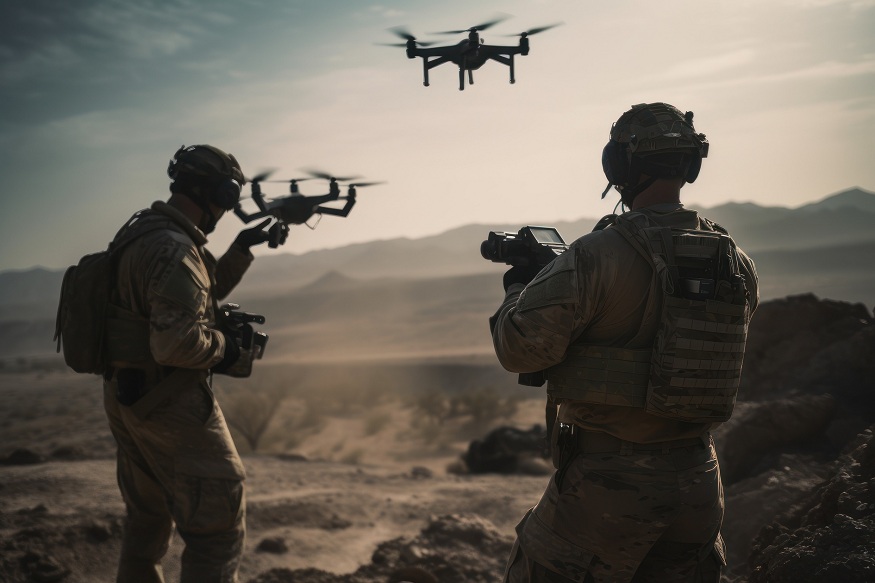Eyes in the Sky: How Tech is Reshaping Modern Warfare
 From battle planning to real-time engagements, breakthroughs in aerial technology transform how conflicts unfold. Once limited to short-range ground assaults, modern military operations now use advanced reconnaissance drones and aircraft to execute missions safer and swifter.
From battle planning to real-time engagements, breakthroughs in aerial technology transform how conflicts unfold. Once limited to short-range ground assaults, modern military operations now use advanced reconnaissance drones and aircraft to execute missions safer and swifter.
Surveillance Infrastructure Takes Flight
The most pivotal advantage drones confer is an eye in the sky for tracking terrain, troops and targets without harming pilots. High-resolution drone cameras and sensors feed commanders an information edge for dynamic planning. Jets that once relied solely on human sight now network with nearby drone cohorts. This expands perspective on surroundings to inform strategic decisions through enhanced situation awareness. By keeping UAVs in constant rotation, military personnel monitor live action from afar while coordinating optimal responses aided by artificial intelligence.
Compact Systems Deploy Faster
In the past, surveilling remote locations meant hauling bulky gear overseas at the mercy of limited flight range. Modern drones collapse such cumbersome equipment into agile, portable frames. Troops now transport recon tools more flexibly between sites by land or air. Quick assembly also allows launching scout drones at forward operating bases nearer to target zones. This equips units with their own eyes in the skies to self-direct patrols, raids and pursuits augmented by streaming data.
Specialized Capabilities Take Any Route
Diverse military operations call for UAVs tailored to specialized settings from desert heat to urban mazes. High-performance drone rotors made by a company like Aerodine Composites empower tactical maneuvers dealing with wind shear or navigating tight spaces. Such versatility suits the right drone to distinct objectives across changing environments. Some models even blend vertical takeoff with sleek forward flight for dual capabilities in one unified system.
Fighter Tech Leaps Ahead
Modern fighter jets also undergo major revamps in response to drones’ advantages. New materials like carbon fiber decrease weight for greater in-flight ability unachievable via bulkier metal hulls. Upgraded jet engines and wings optimize speed, acceleration and responsiveness assisted by computerized flight controls. Their growing air and ground coordination with UAV squadrons concentrates more information where it matters most. This expands pilots’ awareness for executing split-decisions during minutes that matter most.
Hypersonic Capability Takes Off
Even with enhancements though, traditional aircraft still travel far slower than the latest hypersonic tech under development. Hitting speeds above Mach 5, these ultra-fast vehicles could deliver troops, missiles or supplies virtually anywhere on the planet –all within one hour. The capacity for such rapid, unpredictable attack and transport poses a major influence in modern warfare tactics across global militaries.
Covert Surveillance Streamlines Infiltration
Certain assignments rely on lying low from public or rival detection. Smaller spy drones avoid visual notice at lower altitudes. Their quiet electric propellers make minimal noise compared to loud combustion engines. Advanced stealth materials absorb radar, infrared and radio signals normally triggering detection alerts. This helps drones sneak across borders and into secure airspace without arousing suspicion unless spotted visually. Covert mobility remains crucial for various information-gathering objectives or precision rescue missions.
Self-Directed Drones Remove Risk
Push continues toward the development of completely independent aerial drones requiring no human guidance. Algorithmic programming allows basic autonomous navigation by certain UAVs. The final authority for offensive drone strikes remains with human controllers, though. They comply with international laws of armed conflict. Nonetheless, semi-autonomous drones may soon carry ammunition to embattled troops or hazardous areas too treacherous for manned flight. Avoiding risk to pilots expands engagement options where needed most.
Conclusion
From assessing surroundings to rapidly responding, technology drives strategic advantage in modern military maneuvers. Drones lead this charge by enhancing surveillance infrastructure along with aircraft systems evolving in parallel. All signal more powerful command of intelligence, speed and adaptability – factors constantly reshaping warfare’s future battlegrounds.
